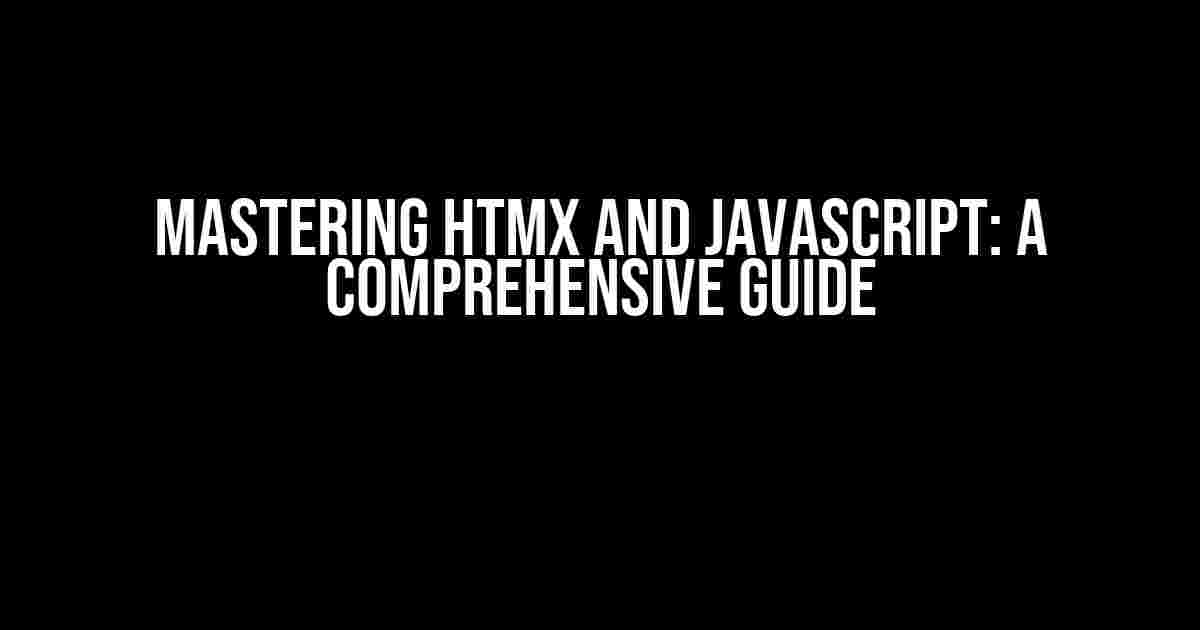Are you tired of tedious page reloads and slow performance in your web applications? Look no further! HTMX and JavaScript are here to revolutionize the way you build dynamic and interactive web pages. In this article, we’ll delve into the world of HTMX and JavaScript, exploring how to harness their combined power to create seamless and efficient user experiences.
What is HTMX?
HTMX (Hypertext Markup Transformation and Multiplexing) is a brand-new library that allows you to create dynamic web pages without the need for JavaScript frameworks or libraries like React, Angular, or Vue. It’s a declarative way of building web applications, focusing on HTML and CSS to create engaging user interfaces. HTMX is built on top of HTML and CSS, making it easy to learn and integrate into your existing projects.
Key Features of HTMX
- Declarative syntax: HTMX uses HTML and CSS to define the structure and layout of your application, making it easy to separate concerns and focus on presentation.
- Real-time updates: HTMX enables real-time updates to your application without the need for full page reloads, improving performance and user experience.
- SEO-friendly: HTMX generates static HTML that’s easily indexable by search engines, ensuring your application is SEO-friendly.
- Low overhead: HTMX has a small footprint, making it ideal for large-scale applications and environments with limited resources.
What is JavaScript?
JavaScript is a high-level, dynamic, and interpreted programming language that’s commonly used for client-side scripting on the web. It’s executed by web browsers, enabling interactive and dynamic web pages. JavaScript is an essential tool for building modern web applications, allowing developers to create engaging user experiences, animate interactions, and respond to user input.
Key Features of JavaScript
- Dynamic nature: JavaScript is an interpreted language, allowing for dynamic behavior and runtime modifications.
- Client-side execution: JavaScript runs on the client-side, reducing the load on servers and enabling real-time interactions.
- Event-driven programming: JavaScript uses events to trigger actions, making it easy to respond to user input and interactions.
- Object-oriented programming: JavaScript supports object-oriented programming, enabling developers to create modular and reusable code.
Combining HTMX and JavaScript
HTMX and JavaScript are a match made in heaven. By combining these two technologies, you can create fast, dynamic, and interactive web applications that provide exceptional user experiences. HTMX handles the declarative syntax and real-time updates, while JavaScript takes care of client-side logic, event handling, and animations.
Step-by-Step Guide to Using HTMX and JavaScript
- Set up your project structure: Create a new directory for your project and add the necessary files, including an HTML file, a CSS file, and a JavaScript file.
- Include HTMX in your HTML file:
<!-- htmx.min.js can be downloaded from the HTMX website --> <script src="htmx.min.js"></script>
- : Create a new HTML file with the HTMX syntax, defining the structure and layout of your application. For example:
<div hx-get="/api/data"> <h1>Loading...</h1> </div>
- Create your JavaScript file: Write JavaScript code to handle client-side logic, event handling, and animations. For example:
<script> // Get the HTMX target element const target = document.querySelector('[hx-get]'); // Handle the HTMX response target.addEventListener('htmx:load', (event) => { console.log('HTMX response received!'); }); </script> - Integrate HTMX and JavaScript: Use HTMX to update your application in real-time, and JavaScript to handle client-side logic and events. For example:
<script> // Send an AJAX request to update the application fetch('/api/data') .then((response) => response.text()) .then((html) => { // Update the HTMX target element target.innerHTML = html; }); </script>
Best Practices for Using HTMX and JavaScript
- Keep your HTMX templates simple and declarative: Focus on defining the structure and layout of your application using HTML and CSS.
- Use JavaScript for client-side logic and event handling: Keep your JavaScript code separate from your HTMX templates and focus on handling client-side logic and events.
- Optimize your application for performance: Use caching, lazy loading, and code splitting to optimize your application’s performance.
- Test and iterate: Test your application thoroughly and iterate on your design and implementation to ensure a seamless user experience.
Real-World Use Cases for HTMX and JavaScript
| Use Case | Description |
|---|---|
| Dynamic dashboard | Use HTMX and JavaScript to create a dynamic dashboard that updates in real-time, displaying key metrics and data. |
| E-commerce application | Build an e-commerce application using HTMX and JavaScript, providing a seamless shopping experience with real-time updates and animations. |
| Blog or news website | Use HTMX and JavaScript to create a fast and dynamic blog or news website, with real-time updates and infinite scrolling. |
| Single-page application | Build a single-page application using HTMX and JavaScript, providing a seamless and interactive user experience. |
Conclusion
In conclusion, HTMX and JavaScript are a powerful combination for building dynamic, interactive, and fast web applications. By following the steps and best practices outlined in this article, you can harness the combined power of HTMX and JavaScript to create exceptional user experiences. Remember to keep your HTMX templates simple and declarative, use JavaScript for client-side logic and event handling, and optimize your application for performance. Start building your next web application with HTMX and JavaScript today!
Get started with HTMX and JavaScript now and take your web development skills to the next level!
Frequently Asked Questions
Curious about HTMX and JavaScript? We’ve got the answers!
What is HTMX, and how does it relate to JavaScript?
HTMX (HTML-over-XMLHTTPRequest) is a JavaScript library that allows you to create interactive web pages using HTML, CSS, and JavaScript. It provides a simple way to create dynamic web pages without the need for complex JavaScript frameworks or libraries. Think of it as a powerful booster shot for your HTML, making it possible to create fast, responsive, and interactive web experiences.
How does HTMX improve performance compared to traditional JavaScript frameworks?
HTMX shines when it comes to performance. By leveraging the power of HTML and the browser’s native rendering engine, HTMX eliminates the need for complex JavaScript frameworks, which can slow down your app. This means faster page loads, snappier interactions, and a more seamless user experience. Plus, HTMX’s server-rendered architecture reduces the amount of JavaScript that needs to be executed on the client-side, resulting in lightning-fast performance.
Can I use HTMX with other JavaScript libraries and frameworks?
Absolutely! HTMX is designed to play nicely with other JavaScript libraries and frameworks. You can use HTMX alongside popular libraries like jQuery, React, or Vue.js to create hybrid applications that take advantage of each technology’s strengths. This flexibility makes it easy to integrate HTMX into your existing workflow and leverage its benefits without having to rewrite your entire app.
How does HTMX handle dynamic content and updates?
HTMX makes it easy to handle dynamic content and updates by using a clever combination of HTML templates, JavaScript events, and server-side rendering. When the user interacts with your app, HTMX sends a request to the server, which returns the updated HTML. HTMX then seamlessly updates the page, eliminating the need for complex JavaScript DOM manipulation. This approach ensures that your app stays fast, responsive, and easy to maintain.
Is HTMX compatible with modern web development tools and workflows?
Yes! HTMX is designed to fit seamlessly into modern web development workflows. It’s compatible with popular build tools like Webpack, Rollup, and Parcel, and works well with modern front-end frameworks like Bootstrap and Tailwind CSS. HTMX also supports modern coding standards, such as ESLint, and is fully compatible with the latest web development best practices.
I hope this helps!






